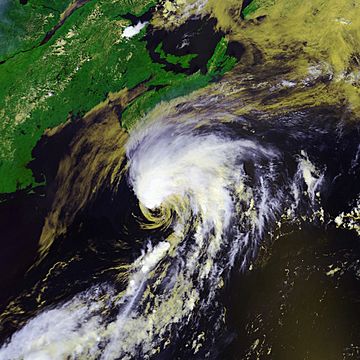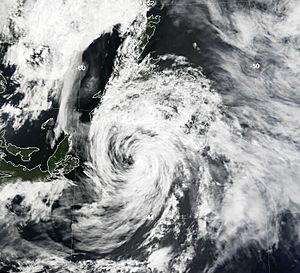2006 Nova Scotia tropical storm facts for kids
| Tropical storm (SSHWS/NWS) | |

Storm near peak intensity.
|
|
| Formed | July 17, 2006 |
|---|---|
| Dissipated | July 18, 2006 |
| Highest winds | 1-minute sustained: 50 mph (85 km/h) |
| Lowest pressure | 998 mbar (hPa); 29.47 inHg |
| Areas affected | Newfoundland |
| Part of the 2006 Atlantic hurricane season | |
The 2006 unnamed tropical storm was a tropical storm that didn't last very long. It was the second tropical storm during the 2006 Atlantic hurricane season. This storm started as a different kind of weather system, called an extratropical cyclone. It formed southeast of Nantucket, Massachusetts.
It then moved over warm ocean waters. This helped it change into a tropical storm on July 17. At that time, a group of thunderstorms formed near the storm's center. The storm quickly grew stronger. It reached its strongest winds of 50 mph (85 km/h). After that, it moved into cooler waters and started to lose its power. By July 18, the storm faded away. What was left of it moved over Newfoundland. Because the storm was not very strong, it did not cause any damage.
How the Storm Formed and Moved
A cold front moved away from the east coast of the United States in mid-July. It then stopped moving over the western Atlantic Ocean. The front eventually disappeared. But it left behind two areas of low pressure. One was south of Cape Hatteras, North Carolina. The other was north of Cape Cod, Massachusetts.
The northern low-pressure area became an extratropical cyclone on July 16. It moved northwest over warm ocean waters. These waters were about 80–82º F (27–28º C). A large group of thunderstorms then formed near the storm's center. On July 17, it officially became a tropical depression. This happened when it was about 240 miles (390 km) southeast of Nantucket, Massachusetts.
The storm then moved northeast. It entered an area where it could get even stronger. It quickly became a tropical storm. The storm continued to gain power. Late on July 17, it reached its strongest winds of 50 mph (85 km/h). At this point, it was about 245 miles (395 km) south of Halifax, Nova Scotia.
After leaving the Gulf Stream, the storm moved into much cooler waters. It quickly lost strength as its thunderstorms faded away. The storm died out on July 18. What was left of it moved over Newfoundland. Then it turned to the east-northeast.
At first, people thought this storm was just a gale storm. But months later, experts realized it had actually become a tropical cyclone. They changed its classification for several reasons.
Storm's Effects and Naming

When the storm got close to Canada, a special ocean buoy measured its winds. It recorded winds of 36 mph (56 km/h). It also measured a wind gust of 44 mph (70 km/h). The storm lost a lot of its power before it moved over Newfoundland. Because of this, it did not cause any damage. The Atlantic Storm Prediction Centre did send out gale warnings for the storm.
Every year, the National Hurricane Center checks to make sure they didn't miss any storms. They found this storm on December 15, 2006. If they had found it when it was active, it would have been named "Tropical Storm Beryl." Experts believe the storm became a tropical cyclone at 39.1º N. This was the farthest north any Atlantic storm in July had become a tropical cyclone. It broke the old record set by Tropical Storm Arthur in 2002.
Related pages
|
Tropical cyclones of the 2006 Atlantic hurricane season |
||||||||||||||||||||||||||
|
|
|||||||||||||||||||||||||
|
|
||||||||||||||||||||||||||
Images for kids




